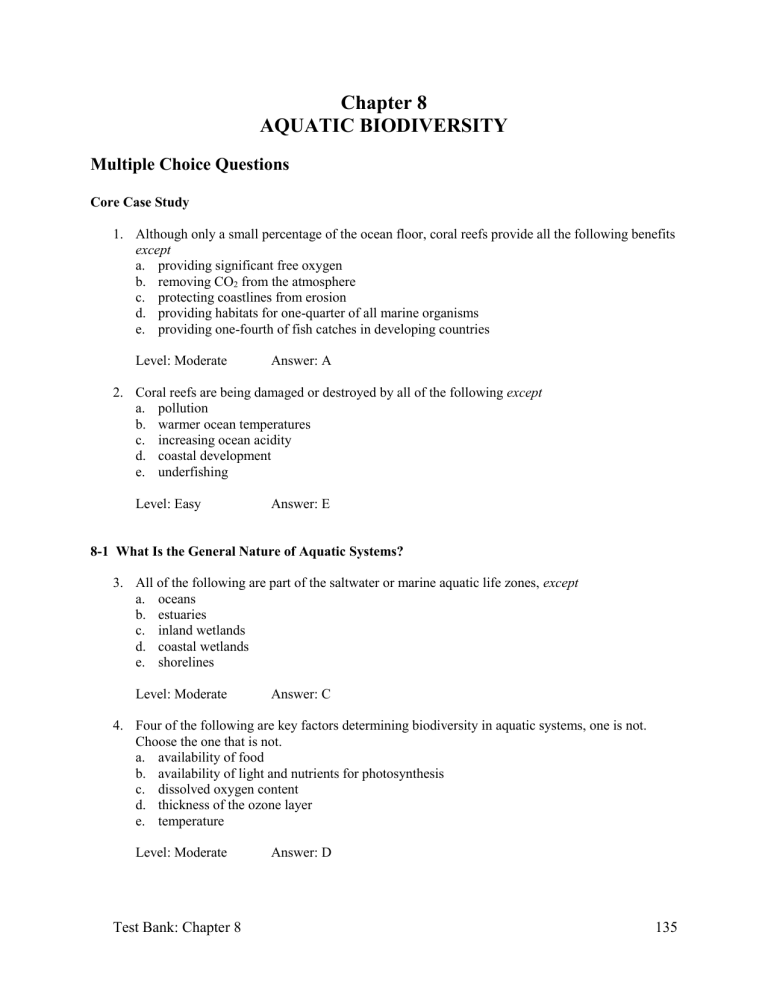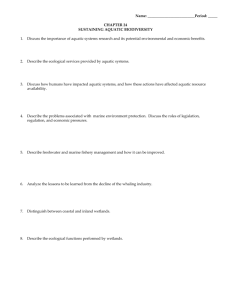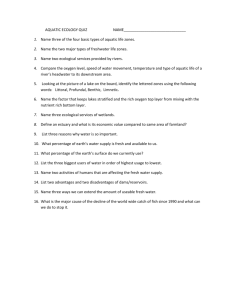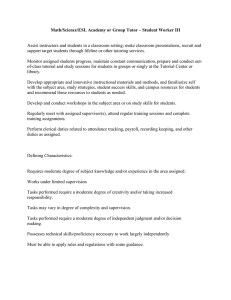
Chapter 8 AQUATIC BIODIVERSITY Multiple Choice Questions Core Case Study 1. Although only a small percentage of the ocean floor, coral reefs provide all the following benefits except a. providing significant free oxygen b. removing CO2 from the atmosphere c. protecting coastlines from erosion d. providing habitats for one-quarter of all marine organisms e. providing one-fourth of fish catches in developing countries Level: Moderate Answer: A 2. Coral reefs are being damaged or destroyed by all of the following except a. pollution b. warmer ocean temperatures c. increasing ocean acidity d. coastal development e. underfishing Level: Easy Answer: E 8-1 What Is the General Nature of Aquatic Systems? 3. All of the following are part of the saltwater or marine aquatic life zones, except a. oceans b. estuaries c. inland wetlands d. coastal wetlands e. shorelines Level: Moderate Answer: C 4. Four of the following are key factors determining biodiversity in aquatic systems, one is not. Choose the one that is not. a. availability of food b. availability of light and nutrients for photosynthesis c. dissolved oxygen content d. thickness of the ozone layer e. temperature Level: Moderate Test Bank: Chapter 8 Answer: D 135 5. All of the following are part of the freshwater aquatic life zones, except a. lakes b. mangrove forests c. inland wetlands d. streams e. rivers Level: Moderate Answer: B 6. If you find a new species of algae floating on the surface of a coastal zone, you would likely consider it a type of a. benthos b. zooplankton c. nekton d. phytoplankton e. ultraplankton Level: Moderate Answer: D 7. Ultraplankton, photosynthetic bacteria, may be responsible for how much of the primary productivity near the ocean’s surface? a. 100% b. 85% c. 70% d. 40% e. none Level: Moderate Answer: C 8. A jellyfish would be considered a type of which of the following? a. benthos b. zooplankton c. nekton d. phytoplankton e. ultraplankton Level: Moderate Answer: B 9. Oysters, clams, and lobsters would be part of which of the following? a. phytoplankton b. zooplankton c. nekton d. benthos e. decomposers Level: Easy 136 Answer: D Aquatic Biodiversity 10. Strongly swimming consumers would be part of which of the following? a. phytoplankton b. zooplankton c. nekton d. benthos e. decomposers Level: Easy Answer: C 11. On a fishing boat, someone catches a swordfish. As a biologist, you would consider this organism a type of a. phytoplankton b. zooplankton c. nekton d. benthos e. decomposer Level: Moderate Answer: C 12. The key factors determining the types and numbers of organisms found in the various layers of both freshwater and marine systems include all of the following, except a. parasitism b. availability of nutrients c. temperature d. dissolved oxygen levels e. availability of food Level: Easy Answer: A 8-2 Why Are Marine Aquatic Systems Important? 13. The ocean zone that covers the continental shelf is the a. bathyal zone b. coastal zone c. littoral zone d. benthic zone e. abyssal zone Level: Easy Answer: B 14. The ocean zone that makes up less than 10 % of the world’s ocean area, yet contains 90 % of all the marine species, is the a. abyssal zone b. bathyal zone c. benthic zone d. coastal zone e. littoral zone Level: Easy Test Bank: Chapter 8 Answer: D 137 15. Which of the following is not part of the coastal zone? a. estuaries b. coastal wetlands c. bathyal zone d. intertidal zone e. coral reefs Level: Easy Answer: C 16. Found along some 70 % of gently sloping sandy and silty coastlines in tropical and subtropical regions, and consisting of some 69 species of trees, are the a. seagrass beds b. barrier beaches c. barrier islands d. coral reefs e. mangrove forests Level: Easy Answer: E 17. Organisms in this area must be able to avoid being swept away, crushed by waves, or being left high and dry at low tides, and must survive daily or seasonal salinity and temperature changes. a. estuaries b. coastal wetlands c. bathyal zone d. intertidal zone e. coral reefs Level: Easy Answer: D 18. The deepest part of the ocean is the a. abyssal zone b. euphotic zone c. estuary zone d. bathyal zone e. benthic zone Level: Easy Answer: A 19. Most photosynthesis in the open ocean occurs in the a. abyssal zone b. euphotic zone c. estuary zone d. bathyal zone e. benthic zone Level: Easy 138 Answer: B Aquatic Biodiversity 20. The dimly lit zone in which zooplankton and smaller fishes predominate, is the a. abyssal zone b. euphotic zone c. estuary zone d. bathyal zone e. benthic zone Level: Easy Answer: D 21. In certain open sea areas winds, ocean currents, and other factors cause water to come up from the depths to the surface bringing nutrient from the ocean bottom. This process is called a(n) a. downdraft b. updraft c. El Niño d. La Niña e. upwelling Level: Moderate Answer: E 22. The zone in which you would expect to find deposit feeders along with oysters, clams, and sponges is the a. euphotic zone b. abyssal zone c. coastal zone d. intertidal zone e. bathyal zone Level: Moderate Answer: B 8-3 How Have Human Activities Affected Marine Ecosystems? 23. Researchers have estimated more than _____ of the world’s mangrove forests have been destroyed by human activities. a. one-fourth b. one-third c. one-half d. two-thirds e. three-fourths Level: Easy Answer: B 24. How much of the world’s ocean area has been heavily affected by human activity? a. 11% b. 21% c. 31% d. 41% e. 51% Level: Easy Test Bank: Chapter 8 Answer: D 139 25. How much of the population of the United States lives at or near a coast? a. more than 95% b. more than 82% c. more than 75% d. more than 66% e. more than 50% Level: Easy Answer: E 26. Four of the following are major threats to marine systems, one is not. Choose the one that is not. a. overfishing b. sinking of ships to create artificial reefs c. runoff of nonpoint source pollution d. invasive species introduced by humans e. habitat destruction from coastal development Level: Moderate Answer: B 8-4 Why Are Freshwater Ecosystems Important? 27. In large lakes there are four distinct zones. Which of the following is not one of those zones? a. benthic b. littoral c. bathyal d. limnetic e. profundal Level: Moderate Answer: C 28. The open, sunlit surface area away from the shore is which zone? a. benthic b. littoral c. bathyal d. limnetic e. profundal Level: Easy Answer: D 29. In lakes, the nutrient-rich water near the shore is part of the a. limnetic zone b. benthic zone c. littoral zone d. profundal zone e. abyssal zone Level: Moderate 140 Answer: C Aquatic Biodiversity 30. Fish adapted to cool, dark waters in lakes are found in the zone called a. limnetic zone b. benthic zone c. littoral zone d. profundal zone e. abyssal zone Level: Moderate Answer: D 31. Which of the following would be characteristic of the profundal zone? a. rooted plants b. low oxygen levels c. nourished by dead matter d. main photosynthetic layer e. turtles, frogs, crayfish, perch Level: Difficult Answer: B 32. Deep lakes with steep banks that have a small supply of plant nutrients are a. oligotrophic lakes b. eutrophic lakes c. culturally eutrophic lakes d. hypereutrophic lakes e. mesotrophic lakes Level: Easy Answer: A 33. Which of the following would be characteristic of a eutrophic lake? a. nutrient overload from human activities b. nutrient levels between the extremes of too much and too little c. small supply of plant nutrients d. well-supplied with nutrients for producers e. excessive nutrients Level: Moderate Answer: D 34. In lakes, large numbers of decomposers are found in the a. limnetic zone b. benthic zone c. littoral zone d. profundal zone e. abyssal zone Level: Easy Test Bank: Chapter 8 Answer: B 141 35. If you fish for trout, you would be most likely to seek out which part of a stream? a. source zone b. benthic zone c. transition zone d. floodplain zone e. profundal zone Level: Moderate Answer: A 36. If you fish for carp or catfish, you would likely need to fish in which part of a stream? a. source zone b. benthic zone c. transition zone d. floodplain zone e. profundal zone Level: Moderate Answer: D 37. Wide, slow-moving rivers containing lots of particulate matter (silt), would be typical of what aquatic life zone? a. source zone b. benthic zone c. transition zone d. floodplain zone e. profundal zone Level: Moderate Answer: D 38. Four of the following are ecological and economic services provided by inland wetlands, one is not. Choose the one that is not. a. filtering and degrading toxic wastes and pollutants b. stopping the recharge of groundwater aquifers c. reducing flooding and erosion caused by storms d. helping to replenish stream flow during dry periods e. helping to maintain biodiversity by providing habitats Level: Difficult Answer: B 39. Most of the wetlands that are lost are used for a. mining b. urban development c. agriculture d. forestry e. recreation Level: Moderate 142 Answer: C Aquatic Biodiversity 40. A type of inland wetland that is dominated by grasses and reeds, with few trees, is a. floodplains b. swamps c. marshes d. prairie potholes e. Arctic tundra Level: Moderate Answer: C 8-5 How Have Human Activities Affected Freshwater Ecosystems? 41. Four of the following are major human activities that disrupt and degrade freshwater systems, one is not. Choose the one that is not. a. Elimination of entire river systems. b. Dams and canals fragment habitats. c. Flood control levees and dikes disconnect rivers from floodplains. d. Cities and farms add excess nutrients and pollution. e. Draining inland wetlands to grow crops. Level: Difficult Answer: A True/False Questions Core Case Study 1. 60 % of the world’s coral reefs have been destroyed in the last 25 years. True False Level: Easy Answer: False 2. Coral bleaching occurs when algae, the food of the corals, die off because of stresses such as increased ocean temperatures. True False Level: Moderate Answer: True 8-1 What Is the General Nature of Aquatic Systems? 3. The distribution of many aquatic organisms is determined largely by salinity. True False Level: Easy Test Bank: Chapter 8 Answer: True 143 4. The saltwater of the earth is a single and continuous body of water. True False Level: Moderate Answer: True 5. In most shallow systems, such as lake edges, nutrients are often in short supply, limiting the net primary productivity (NPP). True False Level: Easy Answer: False 8-2 Why Are Marine Aquatic Systems Important? 6. 40 % of the world’s photosynthetic activity is conducted in the euphotic zone of the oceans. True False Level: Easy Answer: True 7. Barrier beaches and their accompanying sand dunes are the first line of defense against the ravages of the sea. True False Level: Moderate Answer: True 8-3 How Have Human Activities Affected Marine Ecosystems? 8. Some parts of the deepest ocean remain completely untouched by human activity. True False Level: Easy Answer: False 9. A recent study indicates we need to take action quickly on reducing carbon dioxide emissions or the oceans may be too acidic and too warm to support coral reefs. True False Level: Easy Answer: True 10. The Chesapeake Bay Program is an example of the good things that can be accomplished when a coordinated effort is made to accomplish something. True False Level: Easy 144 Answer: True Aquatic Biodiversity 11. Officials of Maryland and Virginia are considering trying to rebuild the Chesapeake Bay’s oyster population by introducing a foreign species of oyster. True False Level: Easy Answer: True 8-4 Why Are Freshwater Ecosystems Important? 12. Standing freshwater is called a lotic system. True False Level: Easy Answer: False 13. Most lakes are hypereutrophic when considering the level of nutrients. True False Level: Easy Answer: False 14. A watershed is the land area that delivers runoff, sediment, and dissolved substances to a stream. True False Level: Easy Answer: True 15. Water in the floodplain zone usually has higher temperatures and less dissolved oxygen than that in the other zones. True False Level: Easy Answer: True 16. Even if the levees around New Orleans are increased by twice their current height, a category-five hurricane will eventually overwhelm them. True False Level: Easy Answer: True 17. The many dams, levees, and canals on the Mississippi River have made the effects of hurricanes much worse on a city such as New Orleans. True False Level: Moderate Test Bank: Chapter 8 Answer: True 145 18. Redirecting Mississippi River sediments through the wetlands and into the Gulf of Mexico, instead of into the Mississippi Delta has caused the Delta to subside (sink). True False Level: Easy Answer: True 8-5 How Have Human Activities Affected Freshwater Ecosystems? 19. About 95 % of wetlands in the United States contain saltwater. True False Level: Easy Answer: False 20. Hawaii has more inland wetlands than the other 49 states put together. True False Level: Easy Answer: False 21. The majority of the wetlands that have been lost since the 1600s have been lost to development of cities. True False Level: Moderate Answer: False Fill-in-the-Blank Questions Core Case Study 1. In terms of biodiversity, __________ are the marine equivalent of tropical rain forests. Level: Easy Answer: coral reefs 8-1 What Is the General Nature of Aquatic Systems? 2. The __________ is the largest of the four oceans, which contains more than __________ of the earth’s water. Level: Moderate Answer: Pacific; one-half 3. The aquatic equivalent of terrestrial biomes are called __________. Level: Easy 146 Answer: aquatic life zones Aquatic Biodiversity 4. The distribution of many aquatic organisms is determined largely by the water’s __________. Level: Easy Answer: salinity 5. In deep aquatic systems the photosynthetic zone is called the __________ zone. Level: Moderate Answer: euphotic, or photic 6. Algal blooms can result in a cloudiness called __________, which can reduce the penetration of sunlight. Level: Easy Answer: turbidity 8-2 Why Are Marine Aquatic Systems Important? 7. __________ are where rivers meet the sea. Level: Easy Answer: Estuaries 8. The vertical zones of the open sea (euphotic, bathyal, and abyssal) are based primarily on __________. Level: Easy Answer: penetration of sunlight 9. Organisms living in the deep waters and on the ocean floor get their food from showers of dead and decaying organisms called __________ __________. Level: Moderate Answer: marine snow 10. Once past the coastal zone, beyond the continental shelf, the ocean is called the __________ __________. Level: Easy Answer: open sea 8-3 How Have Human Activities Affected Marine Ecosystems? 11. __________ __________ is threatening marine ecosystems by warming the oceans and making them more acidic. Level: Moderate Answer: Climate change 12. By 2010, up to __________ pecent of the world’s people are expected to be living on or near the coastal zone. Level: Easy Test Bank: Chapter 8 Answer: 80 147 13. In 2005, pollution levels in Chesapeake Bay resulted in __________ % of the bay, having too little dissolved oxygen to support many kinds of aquatic life. Level: Easy Answer: 40 8-4 Why Are Freshwater Ecosystems Important? 14. A lake is a(n) __________ body of freshwater, which also includes ponds and inland wetlands. Level: Moderate Answer: lentic or standing 15. Precipitation that does not sink into the ground or evaporate is __________ __________. Level: Easy Answer: surface water 16. Surface water becomes __________ when it flows into streams. Level: Easy Answer: runoff 17. __________ lakes are typically shallow, have murky brown or green water, and have high turbidity. Level: Easy Answer: Eutrophic 18. Headwater streams, in the __________ zone, merge to form wider, deeper, and warmer streams that flow down gentler slopes with fewer obstacles. Level: Easy Answer: transition 19. Global sea levels have risen almost __________ meters since 1900 and are expected to rise another __________ meters before 2100. Level: Moderate Answer: 0.3; 0.3 20. Some wetlands are covered with water all year; others remain under water or soggy for a short time each year and are called __________ wetlands. Level: Easy Answer: seasonal 8-5 How Have Human Activities Affected Freshwater Ecosystems? 21. About 80 % of lost wetlands in the U.S. have been destroyed to __________ __________. Level: Moderate 148 Answer: grow crops Aquatic Biodiversity Labeling/Graph Questions Major Life Zones and Vertical Zones Use the Figure above to answer the following questions. 1. Choose the zone in which most organisms are blind or have poor eyesight. Level: Easy Answer: E 2. Choose the zone that contains the majority of all marine species. Level: Easy Answer: A 3. Choose the zone that receives enough sunlight for photosynthesis. Level: Easy Answer: C 4. Choose the zone that is otherwise known as the twilight zone. Level: Easy Answer: D 5. Choose the zone that is divided based on sunlight. Level: Easy Test Bank: Chapter 8 Answer: B 149 Temperate-Zone Lake Life Zones Use the Figure above to answer the following questions. 6. Choose the zone close to shore in which light reaches all the way to the bottom. Level: Moderate Answer: D 7. Choose the zone primarily inhabited by invertebrates, such as decomposers, that can live in the low oxygen. Level: Moderate Answer: C 8. Choose the zone of open water where photosynthesis can occur. Level: Moderate Answer: A 9. Choose the zone that is usually cold and barely penetrated by sunlight. Level: Moderate 150 Answer: B Aquatic Biodiversity Downhill Flow of Water Use the Figure above to answer the following questions. 10. Choose the zone containing wider, lower elevation streams. Level: Moderate Answer: B 11. Choose the zone containing mountain headwater streams. Level: Moderate Answer: A 12. Choose the zone containing rivers that empty into the ocean. Level: Moderate Answer: C Critical Thinking/Essay Questions 1. Briefly explain the major types of organisms in aquatic life zones, giving an example of each. Level: Moderate Answer: plankton – phyto (algae), zoo (jellyfish, protistans), ultra (photosynthetic bacteria) nekton – fish, turtles, whales benthos – oysters, clams, worms, lobsters, crabs decomposers – bacteria Test Bank: Chapter 8 151 2. Briefly explain why estuaries and coastal wetlands exhibit high productivity. Level: Moderate Answer: Estuaries and their accompanying coastal wetlands are where freshwater and saltwater meet and mix. This means that both salt water and freshwater organisms are present, as well as those that can tolerate both fresh and salt water. In addition, the freshwater brings with it nutrients from the land. These nutrients are thoroughly mixed by the tidal movements. Sunlight is readily available for photosynthetic activities since the waters are shallow. 3. Compare and contrast estuaries and intertidal pools in terms of biodiversity. Level: Difficult Answer: Estuaries and coastal wetlands have a wide range of niches available since there are opportunities for fresh water and salt water organisms to make a living. Some organisms are also able to exist in the presence of a mixture of fresh and salt water. Intertidal zones have niches for organisms that must be able to live while covered with salt water and when exposed to the air. Organisms must also be able to withstand reduced salinity when heavy rains dilute the salt water. The intertidal zone organisms must withstand a substantial physical pounding caused by waves and currents. This is normally not an issue with estuaries and wetlands. 4. Explain how the open sea can be both an area of low average primary productivity and the largest contributor to the earth’s overall net primary productivity. Level: Moderate Answer: Average NPP and per unit NPP are low, but the size of the ocean means it contributes a very large amount of the earth’s overall NPP. In addition, the NPP can be much higher in certain areas because of upwellings that bring nutrients from the depths to the surface. These nutrients are used by producers to increase the NPP. 5. Examine figure 8-17 on page 176 of the text. Consider why global warming is likely to cause a lessening of the amount of available freshwater and how that would likely cause changes throughout the downhill flow of freshwater. Level: Difficult Answer: The increase of air temperatures is causing the reduction of glaciers around the world. Glaciers are storehouses for freshwater. The release of this water will reduce the amount of freshwater available to the population of humans and other organisms that are dependent on this resource downstream. In addition, the storage of freshwater in the glaciers regulates the release of the water over an extended period, instead of all at once. If the downstream regions receive their water as a result of precipitation at the source zone and not as a result of melting ice, the water may be sporadically available. Because the total freshwater on earth is less than 3 % of the total water, release of the stored freshwater held in glaciers into the oceans both reduces the salinity of the oceans and the total amount of freshwater. 152 Aquatic Biodiversity


